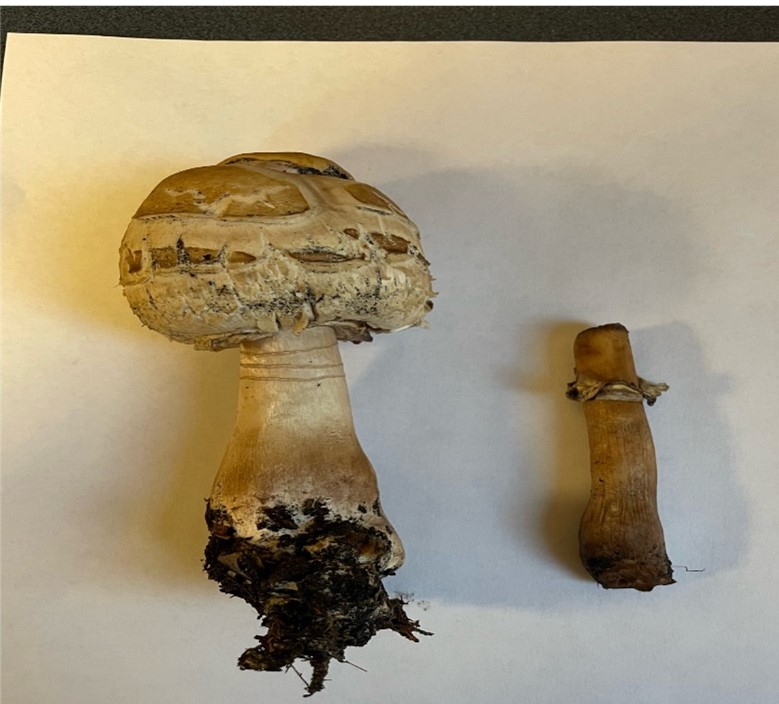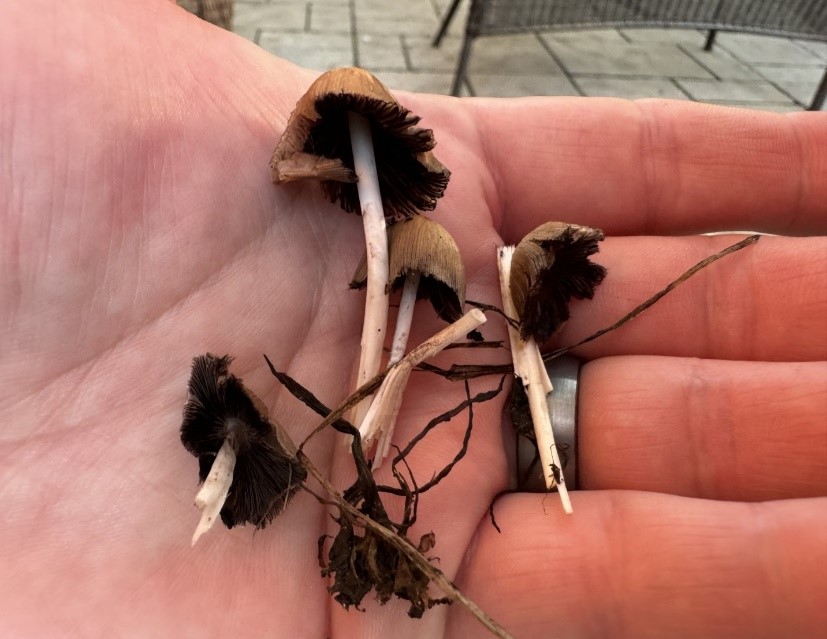Mushrooms have a host of health benefits, from supporting your immune system to protecting brain health. But if you’re thinking of skipping the grocery store, think twice: Wild mushrooms are not always a good bet. In fact, they can be poisonous. If you see a mushroom glowing green in the dark, stop. It’s not a chanterelle. A wild mushroom that looks like a golf ball is most definitely not the commonly sold button variety. Read on to learn about the odd features and unpleasant side effects of eating wild mushrooms.
The Illinois Poison Center (IPC) often fields calls about people eating wild mushrooms. While it’s not always possible to know which mushroom they’ve eaten, we can often rule out harmful ones. Here are some examples of recent calls from the public:
Case 1: Pumpkin Surprise

Two grade school-aged children were given mushrooms to eat that looked like chanterelles. Both children started vomiting two hours after eating them. The mushroom was identified as an Omphalotus olearius also known as a Jack O’Lantern mushroom, which is commonly misidentified as the edible chanterelle mushroom.
Jack O’Lanterns contain muscarine and other toxins that can cause upset stomach. Unlike chanterelle mushrooms, Jack O’Lanterns have gills that can be separated individually from cap. Chanterelles have folds that can’t be separated individually. The gills of a Jack O’Lantern mushroom will also glow greenish in the dark, and the mushroom always grows on decayed wood. In this case, both children were treated at their local hospital and discharged in good health.
Case 2: Eggs ‘n’ Mushrooms

A 50-year-old man picked a mushroom in his neighbors’ backyard. Later that morning his wife cooked the mushroom for him with eggs. Two hours after breakfast he was vomiting and had diarrhea. At the emergency department, he had samples of the mushroom he picked (pictured). An IPC specialist identified it as a Chlorophyllum molybdites, also known as a false parasol or “the vomiter.”
Often found in lawns in early summer, they can look like golf balls before the caps open. Unfortunately, these mushrooms are not edible with eggs or any other food. Despite significant vomiting and diarrhea, the patient was successfully treated and released from the hospital.
Case 3: Don’t Drink With That Ink

A mother of a 2-year-old called IPC after the child ingested an unknown mushroom. She took a photo of its remnants and e-mailed it to IPC. One of our specialists identified the mushroom as a Coprinopsis atramentaria,or inky cap. This mushroom is in fact edible, but do not wash it down with alcohol. It contains a compound called coprine, which once metabolized prevents the body from breaking down alcohol.
Drinking alcohol, even days after ingesting this mushroom, can cause severe symptoms such vomiting, sweating, facial flushing and dizziness.
Identifying Wild Mushrooms
If you want help identifying a wild mushroom, call IPC at 800-222-1222 with the information noted below:
- Mushroom Characteristics: Mushrooms come in many shapes and colors and have different features. These differences are key to identification. Be ready to supply essential information on its physical characteristics, such as the color of the cap and if it has gills or pores, a ring on the stem, or a thickening base.
- Location Details: To assist with identification, tell us where you found the mushroom. Was it in an urban area or a forest? Was it growing on wood, soil or near tree roots? Such details help our specialists narrow down potential mushroom species.
- Detailed Photos: Clear, high-quality photos are essential for accurate identification. Please include several angles of the mushroom. It is important to photograph the top of the cap, undersurface of the cap, side view and any other discernable feature. Putting the mushroom on a contrasting background and having an object next to it for scale also helps. The pictures can be e-mailed to IPC while speaking with a specialist.
Mushroom identification is a fascinating but sometimes tricky process. With the right information, our team of poison specialists can help you identify the mushrooms you encounter and, most importantly, ensure your safety. If you or someone you know may have eaten a potentially poisonous mushroom, don’t wait for symptoms to appear. Immediately call IPC’s 800-222-1222 helpline. You can contact us any hour of the day, all year round. Your call is free and confidential, with free translation service as needed. Check out this blog and/or visit our website for more information on mushrooms. Click here for a free Safety Packet (available in English and Spanish; includes sticker, magnet and first aid tips for poisoning exposure).
Reference:
Marrone, T., & Yerich, K. (2020). Mushrooms of the Upper Midwest: A simple guide to common mushrooms (Mushroom Guides). Adventure Publications.

